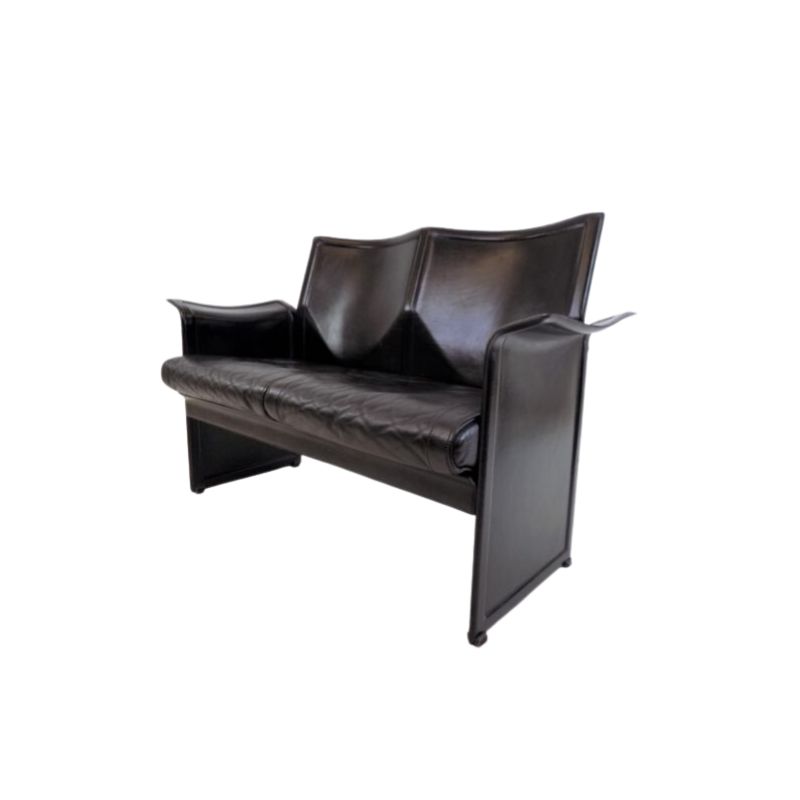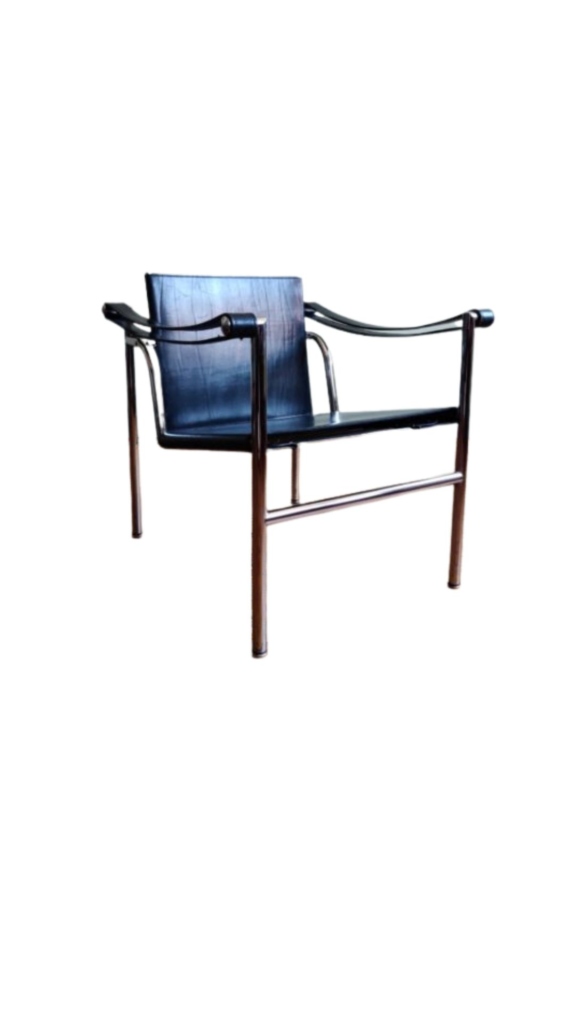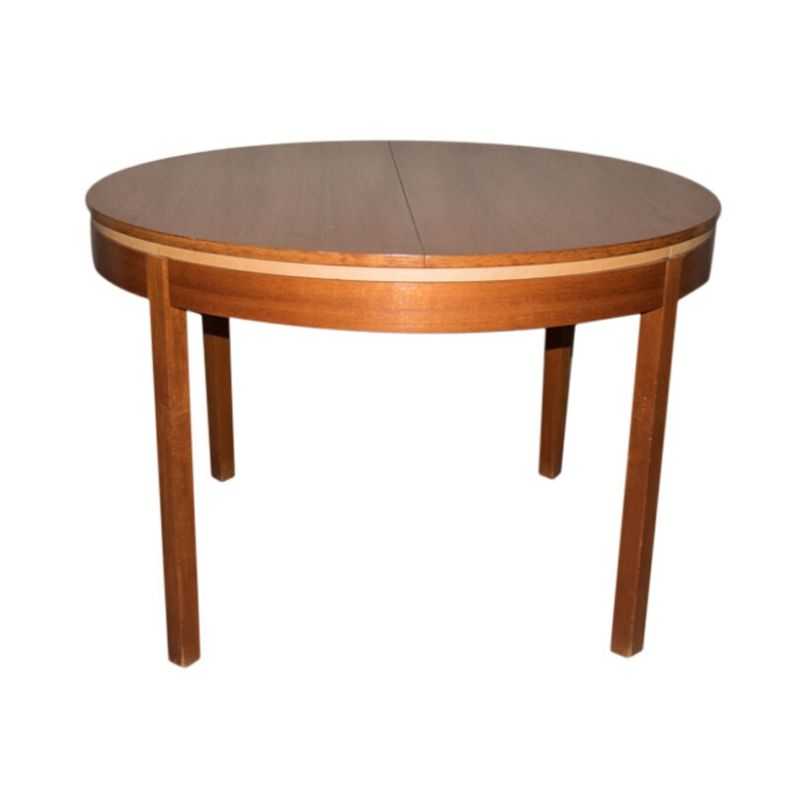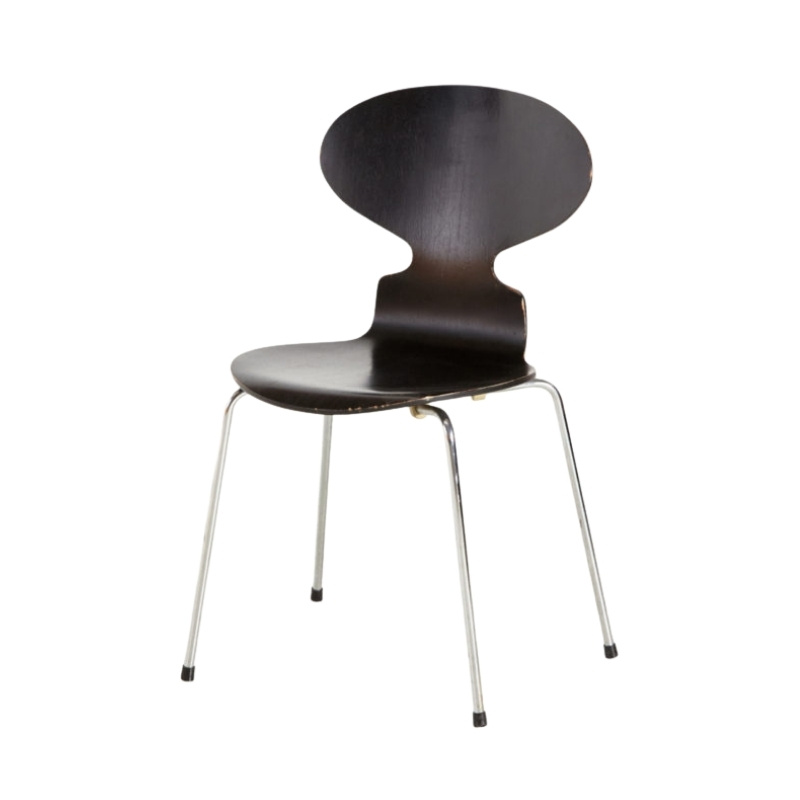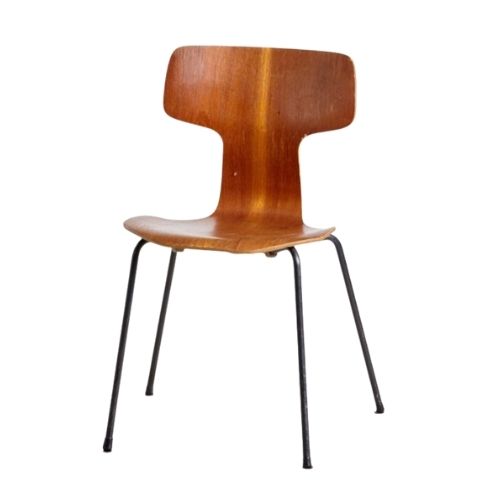I recently bought an LC3 Corbusier design with dark grey frame and light grey leather. It has no marks upon the frame so I assume it is a copy rather than a Cassina authorised version. I read on the Cassina website that Charlotte Perriand helped to revise their range in 1978 with the coloured frames and leathers, which is what the original chairs were like - before they could afford to have them chromed - which must be 1928 (there is a photo of an LC3 with what looks like a painted frame in the library of the whereas the original 1964 Cassinas were chrome frame and black leather. It led me to wonder when these painted-frame copies started being made - as the chair was said to be 'old' and belonged to the aunt of the seller. I wondered if the copies started shortly after 1978 or much later? Mine is a decent copy with double-webbing under the seat and a metal disc on the foot of the legs. I would guess it is over 20 years old - but have no way of knowing. Copies today seem to be mainly chrome frames with one offering a black frame, but none with a dark grey frame and light grey leather - a choice available in the latest Cassina catalogue and perhaps one that was found in the very earliest Corb models? If anyone knows when copies started and by whom I would be interested - I presume they were Italian products?
Hi...
... in Italy it's officially allowed (since 1941) to reproduce any furniture without having a licence.
Actually Cassina is the only one who has the licence for it, but there are since more than fifty years a lot of other italian manufactories.
The only difference is that Cassina may sell their products to foreign countries, the other ones not, but ... 🙂
But anyway the market is full of "wrong" reproductions, and it's quite difficult to make it out, because mostly there is no difference regarding the quality.
when were copies of LC furniture first made.
The first copies of the furniture of Le Corbusier were made in Firenze in 1966 by a Matrix Srl. a buying office and consulting service particularly specialized in matters related to the production and exportation of modern furniture. Matrix offered assistance to US companies who wanted to buy products in Italy and also assisted Italian companies export their production. When in 1964 Casina began to produce the furniture of Le Corbusier they began to claim that these chairs being "artistic works", were automatically protected by copyright. This was completely false because Italian law like that of the USA, England and majority of other countries does not consider Industrial Design a category subject to copyright. The recognition of copyright protection in Italy would have made it impossible to produce in Italy what could be produced in most other countries. To challenge this, Matrix began to put together a collection called "The Classics of Modern Furniture" which included not only the four models of Corbu but also models of Marcel Breuer, Mies van der Rohe, Mart Stamm, etc. In 1968, this collection was distributed in the US by Charlton Inc. then one of the largest distributors of modern design in America. They exhibited the collection at the National furniture Market at HighPoint NC and this extraordinary event was covered by the NY Times and Home Furnishings Daily.
Charlton sold the LC Chaise Lounge at approx. $250 while the Cassina importer was selling the exact same model in comparable quality for $1200. During the first week of that market it was reported the Charlton took orders for almost 1000 pieces and all of the other classic models sold in even larger quantities. Then in 1984, Matrix opened its own factory near Siena which was incorporated as Alivar Srl. It produced a collection of more than 100 medels many of which had not been in production for decades. Cassina started a great number of legal actions against Alivar but lost every one. They lost 3 cases before the Italian Supreme Court. Once the market was freed, many other small companies began to copy the Alivar-Matrix program. These are the source of the low cost models sold in the USA. The original owners of Matrix went into retirement in 1990. They sold Alivar to a financial group who after sold it to a company near Firenze who had nothing to do with the original company. The original matrix was given by the owners to employees of Matrix-Alivar who continue to run it as Matrix International.(www.matrixinternational.it) It is a serious company that produces high quality furniture
Note well that Cassina even after losing Supreme Court Cases continued to claim that they have the exclusive rights to the furniture of Le Corbusier. They convinced the Berlusconi government (bunga-bunga) to change the Italian copyright law to include industrial design and have been fighting to eliminate all competition. Hopefully, they will beaten down another time.
E 1027 House
I know its a bit off subject, but the mention of Corbusier always reminds of his claims to have designed Eilleen Gray's E1027 house. Apparently he was obsessed with the small modernist home and did everything he could to eventually secure it. Corbusier's vandalism of Gray's simple design, via the addition of the painting of Picasso style murals is well documented. It's such an interesting story.
http://blog.ounodesign.com/2008/12/24/eileen-gray-e1027-house/comment-pa...
Eileen Gray was a close frien...
Eileen Gray was a close friend of Jean Badovici,the architect who owned the property and the house. The house was designed by Eileen Gray with the technical supervision of Badovici. Eleen Gray was not a trained architect. Badovici was the publisher of the Collected Works of Le Corbusier. Le Corbusier made no secret of the fact that he disapproved of the layout of the house. In particular, Le Corbusier was very disturbed by the manner in which one entered the house and the way in which one passed from one room to another. For him,walking through an architectural work was an important experience and Le Corbusier felt that it had been handled badly. Since Badovici had been the architect, Le Corbusier attributed the reponsibility for this defect to Badovici rather than to Eileen Gray. Le Corbusier admired Eileen Gray as a designer and praised the furniture in the house. It would seem that Le Corbusier was not aware or had not been informed by Badovici of the extent to which Eileen Gray was involved in the design of the actual building. As a gift to friends Le Corbusier would often execute a painting on the walls of their houses. Since he was an architect, artist,writer and intellectual of international fame, it was considered by all as a gift of great value. In this case, the execution of paintings on nine walls of the house was interpreted as an act of vandalism. Not apparently intended as such, it seems that he never imagined Eileen Gray would be insulted by his intervention. Le Corbusier later built his Cabonon on the property adjacent to this house. When Badovici died the house was put on sale and Le Corbusier asked his Swiss friend Willy Boesiger to find a Swiss buyer because he was terrified by the idea that the house would be inhabited by noisy "Americans." In 1958,Boesiger asked the young Swiss designer and businesswoman Heidi Weber to handle the situation. Heidi Weber went to visit Le Corbusier in Cap Martin and after three days of discussion he was so impressed by the enthusiastic dynamism and intelligence of this young woman that he accepted her proposal to produce his furniture and sell his art works. She remained one of his closest collaborators during the last eight years of his life. She was the first person to put the four furniture models of Le Corbusier into regular production. The Heidi Weber models are those which are deposited in MOMA. They were of an extraordinarily high quality but expensive. Seven years later, in an attempt to produce a lower cost production that would make the models available to ordinary people she gave a sub-license to an Italian company called Cassina which produced furniture for hotels and ocean liners. The Cassina models were less costly than the Swiss originals.
reconstructing history of the Corbu models
Corbu sent sketches of sitting positions to his editor with a note dated April 1927 saying " Le Corbusier once again dedicates himself to the classification of the ways of sitting in view of designing chairs himself." Then in a letter to Alfred Roth dated July 21, 1927, Le Corbusier promised to send him within 8 days drawings of chairs which he intended to produce in France.This indicates that the models were clearly set in his mind and, as was his habit, he had already sketched them prior to that date. Corbu did all of this months before Perriand arrived on the scene. It wasn't until the winter of late 27, early 28 that Corbu decided to make executive drawings. Pierre Jeanneret (Corbu's younger counsin and junior partner)who had fallen desperately in love with Perriand, begged Corbu to associate her in the project as his freelance assistant.Corbu reluctantly agreed. Perriand in a court case testified that on the first day of work, Corbu arrived with sketches of the models to be produced and worked together with Jeanneret an her in the transformation of these sketches into formal executive plans. The drawings were made under the notoriously severe control of Corbu. It was then the task of Jeanneret and Perriand to supervise the artisans who would produce the prototypes. Despite the favorable impression created by the photos of Lucien Hervé, if examined at close range the models evidenced serious defects and were not suitable for industrial production.In particular, the Grand Confort tilted backward. The models had been painted not for stylistic or economic reasons but because the finish of the tube was too rough to permit nichel or chrome plating. The paint hid the defects. In 1929,Thonet put into production only two of the Corbu models, the chaise longue and the small camp chair (basculant) These two models were corrected, completely restyled and properly industrialized by the director of Thonet Bruno Weil(also famous as the designer Béwé) Thonet refused to produce the Grand Comfort armchairs. The Grand Confort models were put into production for the first time in 1958 by Heidi Weber who corrected them and gave all of the four models a unified appearance.
LC copyright.
The Le Corbusier furniture is in the public domain in the United States, the British Commonwealth countries
(England,Ireland,Canada, Australia. etc.)and almost all of the Asian, African and South and Central American Countries.. In these countries works of industrial design are not considered works of Authorship that can be subjected to copyright protection. Consequently, any person or company can legally produce these models without a licence. As opposed to a "design patent" which can protect the exclusivity of an original appearance of an industrial product for a limited period of time (normally less than 25 years) a "copyright" protects works of "authorship" and is related to the lifetime of the author. A work of authorship is a creative work that expresses the unique individuality and personality of an individual human being to the extent that he or she is its author. On the other hand, the design of an industrial product is not "free act of creativity" but conditioned by economic and technical necessities.It is forced to include the "know-how" of previous designers. The extension of artistic Còpyright to Industrial design is a European invention of French and German origin. It is a trade barrier which penalizes the consumer because it creates a growing category of non-competitive merchandise. As you noted, the Cassina products are more or less the same quality as the copies. However, they are double the price because they are supposedly "authorized". The copyright law in Italy was modified during the 1990's as a favor to Cassina by the government of Silvio Berlusconi (bunga-bunga). I might conclude by noting that the Cassina models are far from authentic. The proportions and detailing of the Grand Confort models have been changed for economic reasons to the point that they are notceably different from the originals of Corbu. They have attributed models to Le Corbusier which were not his work. In 1984,Heidi Weber( the original producer of the furniture who had sub-licensed Cassina) wrote a letter to the Le Corbusier Foundation of Paris complaining that the copies were more original than those of Cassina.
LC copyright.
The Le Corbusier furniture is in the public domain in the United States, the British Commonwealth countries
(England,Ireland,Canada, Australia. etc.)and almost all of the Asian, African and South and Central American Countries.. In these countries works of industrial design are not considered works of Authorship that can be subjected to copyright protection. Consequently, any person or company can legally produce these models without a licence. As opposed to a "design patent" which can protect the exclusivity of an original appearance of an industrial product for a limited period of time (normally less than 25 years) a "copyright" protects works of "authorship" and is related to the lifetime of the author. A work of authorship is a creative work that expresses the unique individuality and personality of an individual human being to the extent that he or she is its author. On the other hand, the design of an industrial product is not "free act of creativity" but conditioned by economic and technical necessities.It is forced to include the "know-how" of previous designers. The extension of artistic Còpyright to Industrial design is a European invention of French and German origin. It is a trade barrier which penalizes the consumer because it creates a growing category of non-competitive merchandise. As you noted, the Cassina products are more or less the same quality as the copies. However, they are double the price because they are supposedly "authorized". The copyright law in Italy was modified during the 1990's as a favor to Cassina by the government of Silvio Berlusconi (bunga-bunga). I might conclude by noting that the Cassina models are far from authentic. The proportions and detailing of the Grand Confort models have been changed for economic reasons to the point that they are notceably different from the originals of Corbu. They have attributed models to Le Corbusier which were not his work. In 1984,Heidi Weber( the original producer of the furniture who had sub-licensed Cassina) wrote a letter to the Le Corbusier Foundation of Paris complaining that the copies were more original than those of Cassina.
Copyright about to change....
It looks like the copyright laws are about to change in the UK (see link below). The report outlines a plan to re-establish copyright for the life of the designer plus 70 years, and that means only licensed pieces can be made.
Beyond the debate over copy, licensed copy, replica, etc there is a much bigger issue which is rarely discussed on this forum.. The replica market is global and it does have an impact beyond price and copyright issues. Organized crime gangs around the world trade in counterfeit designer goods which includes classic furniture, often made by slave labour, and the proceeds are used to fund more sinister crimes such as human trafficking, deforestation of rain forests, organ harvesting, you name it.
Whether its licensed or not, I am not about to choose a designer object over the human rights of someone else. The notion that design can improve lives should include the people on the factory floor, and as a design community we should all be rallying against the use of classic designs to fund organized crime.
Perhaps a change in copyright law may help reduce the profits made by these crime gangs who sell their designer knock-offs to so-called reputable stockists. This isn't about economics, its about ethics and the human cost that many people are willing to overlook in order to appear fashionable to their peers.
http://www.parliament.uk/documents/impact-assessments/IA12-014J.pdf
reply to tick re designcopyright
The supposed claim by an allegedly authorized producer of classic models that it loses 250 million Euro a year in business due to the current British Law is laughable nonsense, typical of the meaningless misinformation and baseless commercial propaganda that Cassina has been circulating for years.The entire volume of Classic models sold in Britain both authorized as well as copies certainly, in no way arrives at such an enormous figure. This intervention deliberately oversimplifies a highly complex situation. It begins by flatly asserting that chairs and tables of modern design are recognized as works of art in Britain and then goes on to arbitrarily presume that the design of a chair or a table deserves the same copyright protection as a work of literature or fine art. Even if this lobby manages to lenghten the period of copyright protection of industrially produced "works of art"(Lithographs,Etchings, multipes of sculptures,etc.) it is difficult to imagine that British Law will automatically extend copyright protection to the industrial design of functional objects such as chairs and tables. Then also,it should be noted that companies that pretend to possess the exclusive rights to the famous "classic models" base their claims on license agreements of dubious value. They do not stand up under critical analysis.
Cassina has gone as far as inventing heirs that weren't real heirs and was even condemned by the presigious Gurí della Pubblicità of Milan (autodisciplinary authority of the Press) for pretending the exclusive rights to the furniture of Mackintosh on the basis of a contract with the University of Glasgow which was by no means the heir of Mackintosh.Cassina actually used this contract to threaten and take legal action in Germany against companies that supposedly "violated their copyright". The claim that the mafia is involved in the production of unauthorized models of furniture is completely and absolutely false. The classic models are low-turnover items that are expensive to pack and to ship because of high volume and fragility.The total value of a 40foot container of furniture is only a fraction of the value of a similar container filled with fashion merchandise, handbags, phoney watches, etc. Consequently, the classic models have never been of interest to those involved in the mass production and distribution of falsified merchandise. Cassina has always deliberately confused the violation of Trademark with the supposed violation of Copyright.It is all part of an aggressive program of defamation aimed at criminalizing competitors. All of the mountains of false merchandice are cheap, manufactured items of low volume which are marked with false easy-to-recognize designer labels (Gucci, Valentino,Vuitton, etc.)It is unimaginable that furniture be labeled with the names of companies such as Knoll, Cassina, Vitra.
Who mentioned Cassina?
If you are going to reply to my post please do me the courtesy of responding to the contents of the post itself. It is well documented that there is a link between counterfeit designer goods (including furniture design) and organized crime. There are task forces set up across the globe to deal with this area of crime.
Now I'm not sure what your gripe is with Cassina and licensing of Knoll, etc, but I am not referring to the semantics around ownership here. If you have a vested commercial interest you should declare it, as to not do so, would be a clear conflict of interest.
Getting back to my previous post. After a successful campaign by Elle magazine, it now looks likely that the laws in the U.K. will be changed to award copyright to the original designer for his/her lifetime plus 70 years. I look forward to the implementation of this law. I look forward to a time that emerging designers can actually benefit financially from the years of R&D they put into developing their designs. I look forward to a time where cheap knock-offs of original designs vanish from the landscape.
Yes, it's true that there is very little stopping manufacturers from making copies of original designs but all that is about to change. I personally preferred it when people valued well designed and made furniture for its highly developed aesthetic and quality rather than as a status object.
If you would like to read the 2007 OECD report on Counterfeiting and Piracy there is a link below.
In regards to Perriand and Gray, it's fair to say that they were exceptionally talented designers. From what I have read about Le Corbusier, it would be impossible for anyone to meet his standards, especially a woman. As you know, when Perriand requested a job he replied "we do not embroider cushions here". And even though Le Corbusier is said to have created a series of erotic drawings of lesbians, his mysoginist comments are hard to overlook. I guess Eileen Gray had the last word with her furniture going down in history as the most highly desired and most expensive pieces in the world.
http://www.oecd.org/industry/ind/38707619.pdf
reply to "tic"
I retired from the furniture business more than 20 years ago and I do not, in any manner,directly or indirectly represent the commercial or economic interests of any furniture company or financial group. I am not on anyone's payroll nor have I ever recieved or accepted any payment or remuneration for anything that I have written regarding furniture. In effect, I am what you might describe as an "historian of industrially produced modern furniture" and in a great number of occasions over the years I have been asked by companies involved in controversies involving alleged "design rights" or by legal firms representing them, to submit written opinions dealing with the historical background of the objects in question and to review the documentary evidence available. However, I have only contributed to the defense of those who, in my opinion, have been unjustly accused or whose rights have been violated. All of this I have done free of charge without expecting anything in return. Consequently, your insinuation that I am a person with hidden commercial interests and suffering from a "conflict of interest" is simply not true. However, your suspicion seems to be symptomatic of the probable fact that yourself are not what you pretend to be;a socially conscious lover of design, worried about the rain forests,outraged by the infiltration of the mafia and up in arms against the exploitation of slave labor in the production of "unautorized" furniture.
The fact that you that you knew of the existence and went to the trouble to ask permission to add as a link to your intervention an obscure document of the OECD that was published way back in 2007, clearly identifies you as a part of a lobby. Moreover, your interpretation of the document is completely distorted and deliberately misleading. Your claim that this document proves that there is a link between criminal organizations and "counterfeit" furniture designs is completely false. The document if properly read shows that this is highly improbable. This text includes furniture in parenthesis because although Cassina keeps on repeating this the OECD found no clear evidence that this was true.
Finally, if the British Parliament is willing to compromise their country's the long and well established legal tradition supporting free trade and competition because they have been influenced by articles in Elle, a Hearst Publication, then England is certainly in trouble.
Tit-for-tat
To be honest, I was not sure if I should bother replying to the previous post, but seeing as I am a part of a sinister lobby misleading the public, I felt it my duty. Not wanting to engage in a tit-for-tat and it's obvious that you actually never read my post. The OECD report I found online simply provides a definition of piracy, which includes furniture. You're right, I'm not who I claim to be, I am part of a sinister lobby who care about design.
The lobby is called the Design Addict Community.
Why shouldn't I be outraged that crime gangs are involved in the making
of fake designer goods? We should all be outraged that rain forests in parts
of Asia are being torn down to fuel our desires for timber products. That's my opinion and I think it's a valid one.
I think your response clearly demonstrates your position, and that's fine,
but don't go on the attack because someone disagrees with you, your
not in the office now. And for the record, I am an academic and researcher whose research on post-war industrial designers is archived by my country's National Library.
By the way, if you also value design, there is a thing called a paragraph, you should try it. Trolling was the last thing I expected to find on DA, but it's seems to be everywhere these days.
If you need any help, please contact us at – info@designaddict.com



